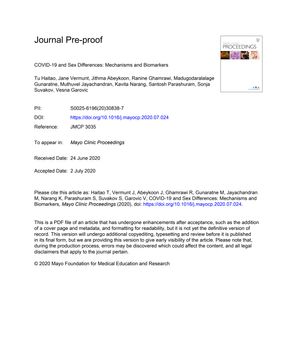COVID-19 and Sex Differences: Mechanisms and Biomarkers
August 2020
in “
Mayo Clinic Proceedings
”

TLDR Men are more likely to have severe COVID-19 cases and fatalities than women due to factors like lifestyle, aging, and biological differences.
The document "COVID-19 and Sex Differences: Mechanisms and Biomarkers" discusses the gender disparities in COVID-19 outcomes, with men being overrepresented in severe cases and fatalities. This is attributed to gender-specific behaviors, genetic and hormonal factors, and sex differences in biological pathways related to SARS-CoV-2 infection. The paper suggests that ACE2 expression, which aids viral entry and invasion of cells, is generally increased in men and decreased in women. It also notes that patients with COVID-19 who required hospital admission often exhibit androgenic alopecia, suggesting a potential link between androgen levels and disease severity. Males with severe COVID-19 have higher CRP concentration and exhibit significantly higher IL-2 and TNF-alpha levels compared to females, which could contribute to their higher susceptibility to developing cytokine storm and poorer COVID-19 outcomes. Females generally have stronger immune responses, with higher antibody production and more efficacious vaccine responses, possibly due to the anti-inflammatory effects of estrogen. The document concludes that males have a higher COVID-19 case fatality rate and increased disease severity compared to females, likely due to a combination of lifestyle risk factors, prevalence of co-morbidities, aging, and underlying biological sex differences. However, the role of biological sex in infection risk and disease severity is complex and data are not uniformly consistent.





